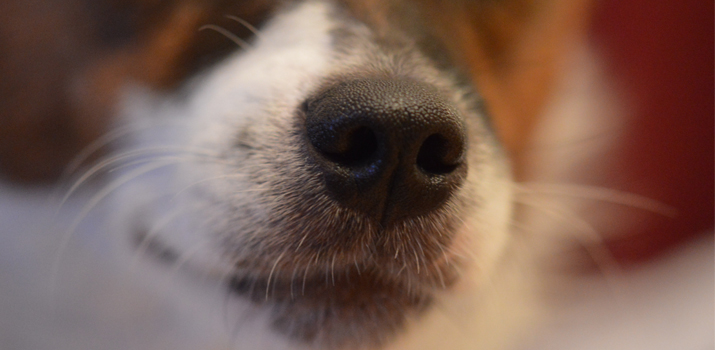Most people have heard that old adage about dog noses at some point in their lives. "If your dog's nose is dry and crusty, they're suffering from an illness." While that's not necessarily true in all cases, you can learn a lot about your pooch from looking at their nose.
It's a good indicator of their overall health. Major changes shouldn't be ignored.

One of the most alarming issues that some dog owner see is a change in color. Also known as depigmentation, these changes can appear suddenly. In some cases, the new color is permanent. But what exactly is causing it?
There are a number of reasons why this may be happening. Sometimes, it's an innocent change with a quick fix. Other times, it could be an indicator of an underlying health issue. Here are some common reasons why your dog's nose may be changing colors.
#1. Winter Nose
Winter nose, also known as snow nose or seasonal hyperpigmentation, is a fairly common cause of color issues. It can affect a number of different breeds. However, it's most common in dogs with a history of living in the snow.
These breeds include the Siberian Husky and the Alaskan Malamute The condition gets its colorful name because it usually affects dogs when the temperature starts to drops. Your dog may start off with faded patches. As the winter season goes on, the patches will get bigger.
There are a few theories as to why this happens. The most accepted is that the change is caused by the Tyrosinase enzyme. This enzyme is responsible for producing pigment in your dog's nose. Unfortunately, cold weather has a big effect on the enzyme's functionality. This results in the depigmentation.
The good news is that there's no immediate cause for concern. It's a perfectly normal condition that has no effect on your dog's overall health. The issue will subside once the weather gets warmer. Your dog's nose will return to normal.
#2. Age
It's not uncommon to see a dog's nose change colors as they get older. Many young puppies are born with flesh-colored noses. As they get older, it will darken to a deep black. However, some dogs can also have a dark brown nose or one that's the same color as their coat.
Once they're adults, your dog's nose color will usually stay the same for most of their life. That is, however, until they reach senior status.
Like snow nose, depigmentation with age is likely caused by the Tyrosinase enzyme. The enzymes tend to get weaker as your pooch reaches their senior years. You may notice the color change from black to a light brown. For some dogs, their noses fade to pink. Like the previous case, there is no cause for concern. It's the dog equivalent of going gray.
#3. Vitiligo
Vitiligo is a unique condition that's marked by pigmentation issues throughout the entire body. Humans can experience Vitiligo just like dogs. It's generally considered an autoimmune disorder, so it's a good idea to consult with your vet for possible treatment options.
In addition to depigmentation of the nose, you may notice pink patches of skin or white hair. While it can affect virtually any breed, Rottweilers are more susceptible to the condition.
#4. Chemical Reactions
Sometimes, the culprit is your dog's very own water dish. Plastic water dishes have been known to cause issues with dogs. Plastic Dish Nasal Dermatitis is a condition that's caused by the chemicals in the material. More specifically, it's caused by p-benzyl hydroquinone.

If you're familiar with cosmetic products, you may recognize that name. Hydroquinone is commonly found in bleaching products and skin lighteners. It can have the same effect on your dog.
The chemical comes off of the plastic and gets into your pup's water. Each time they dive in to get a drink, they're being exposed to it.
Many times, the chemical absorbs into the skin and interacts with the melanin, which is the natural pigment that gives your dog's nose its signature color.
Luckily, most owners see significant improvement once they replace their dog's plastic water dish with a steel one. Over time, your dog's nose color may return to normal.
#5. Immune Disorders
In addition to Vitiligo, there are a number of immune disorders that could affect your dog. It's important to take your dog to a vet as soon as possible. They'll be able to perform tests and diagnose the problem.
For most of these disorders, depigmentation of the nose is just one of many other symptoms your dog may have.
One common disorder is called pemphigus foliaceus. This condition is common in Chow and Akita breeds. One of the biggest symptoms of this disorder is crusting skin. It can make itself known around the ears and nose. The skin problems are caused by keratinocytes issues within the epidermis. Luckily, it is manageable with an effective treatment plan.
Vogt–Koyanagi–Harada syndrome, also known as VKH, is another possible cause. It's commonly believed to be a genetic disorder that's found in Siberian Huskies, Akitas, Australian Shepherds, and Samoyeds. Treatment often involves corticosteroids. With this disorder, the compounds that produce melanin are attacked by the immune system. This is what causes the pigmentation issues.
#6. Skin Issues
There are a few different skin issues that can cause depigmentation. One of the simplest is an injury. Scrapes and cuts can result in scabs and crusty skin. This is usually followed by changes in color as the injury heals.

Depending on the severity of the injury, your dog's normal skin color should return. However, significant scarring can leave a permanent change.
Infections are very similar. Whether your dog has a nasal infection or a skin infection, depigmentation is to be expected.
Infections are usually accompanied by swelling and discharge. It's important to seek veterinary care as soon as possible to prevent the infection from spreading and causing further issues.
If your dog is allergic to something, they may experience an unwanted reaction on their nose. In medical terms, this issue is called Contact Dermatitis. Dogs explore the world by sniffing around. Unfortunately, their noses are often the first to be affected by stimulants. In most cases, removing the offending item will cause the reaction to subside.
#7. Cancer
While no dog owner wants to think about cancer, some forms of the disease result in skin color changes. Cancer attacks the body from within, resulting in physical changes over time. Skin cancer is the most likely culprit.
Because your dog's nose is one of the most visible parts of their body not covered by fur, symptoms of cancer are sometimes first noticed there.
Nasal tumors can form inside your dog's nose as well. It's most prevalent in dogs with light coats. Dogs who spend a lot of time outside are also exposed to UV radiation, thus increasing their risks of suffering from cancer.
If you suspect that cancer is the cause of your dog's nose discoloration, it's imperative that you consult with your vet for a proper diagnosis.
Final Thoughts
As you can see, your dog's nose depigmentation may be caused by a number of different reasons. If you're worried about the change in your dog's appearance, you should monitor their nose and seek professional guidance. A veterinarian is equipped to provide you with answers.
In most cases, the change is temporary. In the event that your dog is experiencing a more pressing health issue, you can get them the help that they need.

